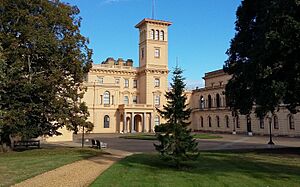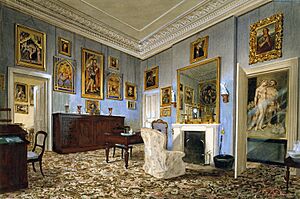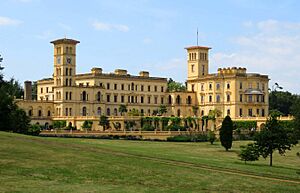Osborne House facts for kids
Quick facts for kids Osborne House |
|
|---|---|
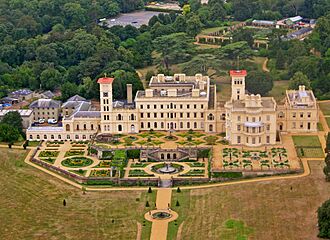
Aerial view of Osborne House
|
|
| General information | |
| Architectural style | Italian Renaissance |
| Location | Isle of Wight |
| Town or city | East Cowes |
| Country | United Kingdom |
| Coordinates | 50°45′02″N 01°16′11″W / 50.75056°N 1.26972°W |
| Construction started | 1845 |
| Completed | 1851 |
| Design and construction | |
| Architect | Prince Albert (designer) |
| Engineer | Thomas Cubitt (builder) |
Osborne House is a beautiful former royal home located in East Cowes, on the Isle of Wight in the United Kingdom. It was built between 1845 and 1851 for Queen Victoria and Prince Albert. They used it as a special summer home and a quiet place to relax away from busy city life.
Prince Albert himself designed the house. He wanted it to look like an Italian Renaissance palace. The builder was Thomas Cubitt, a famous London architect. His company also built the main front of Buckingham Palace for the royal couple. An older, smaller house on the land was taken down to make room for the much larger Osborne House. However, the original entrance gate still stands today.
Queen Victoria passed away at Osborne House on January 22, 1901, when she was 81 years old. After her death, her son, King Edward VII, gave the house to the country. He did this on the day he became king. The part where the royal family lived was kept as a private museum for Victoria.
From 1903 to 1921, some of the buildings around the stables were used as a training college. It was for young officers in the Royal Navy, called the Royal Naval College, Osborne. Another part of the house became a place for officers to recover from illness. In 1954, Queen Elizabeth II allowed the private rooms on the first floor to be opened to the public. Since 1986, English Heritage has looked after Osborne House.
The house is a very important historic building, listed as Grade I. Its beautiful park and gardens are also listed as Grade II*.
Contents
History of Osborne House
A Royal Getaway
Queen Victoria and Prince Albert bought Osborne House on the Isle of Wight in October 1845. They really wanted a home where they could escape the busy life of the royal court. Victoria had visited the Isle of Wight twice as a young girl. Her mother, the Duchess of Kent, had rented a nearby estate called Norris Castle.
Victoria and Albert loved the location of the old three-story Georgian house. The views of the Solent (the sea strait) reminded Albert of the beautiful Bay of Naples in Italy. They soon realized the old house was too small. So, they decided to build a brand new, much bigger home.
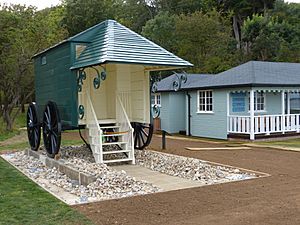
The new Osborne House was built between 1845 and 1851. It was designed in the Italian Renaissance style, with two tall towers called belvedere towers. Prince Albert designed the house himself. He worked with Thomas Cubitt, the London architect and builder. Cubitt's company also built the main front of Buckingham Palace. The royal couple paid for much of the new house's furniture by selling the Royal Pavilion in Brighton.
Prince Albert was very involved in planning the estate, gardens, and woodlands. He wanted to show his knowledge of forestry and landscaping. At other royal homes, he had to follow the rules of official forest managers. But at Osborne, he had more freedom. Below the gardens, on Osborne Bay, was a private beach. Here, the Queen had her own special bathing machine. This machine was very fancy, with a front porch and curtains. It allowed her to get into the water privately.
The first part of the house built was called "The Pavilion." It had the main rooms for guests and royal apartments on different floors. The main rooms show how Queen Victoria was connected to other royal families in Europe. For example, the Billiard Room has a huge porcelain vase and a mosaic table. These were gifts from the Russian Tsar Nicholas I when he visited Britain in 1844. The Billiard Room, Queen's Dining Room, and Drawing Room on the ground floor all look very grand.
In contrast, the royal family's private rooms on the first floor were much more cozy and simple. These included Prince Albert's Dressing Room, the Queen's Sitting Room, the Queen's Bedroom, and the children's nurseries. These rooms were made to be as comfortable as possible for private family use. Both Queen Victoria and Prince Albert wanted to raise their children in a natural and loving way. They let their children visit their parents' bedrooms often. This was unusual at the time, as many aristocratic children lived separately in nurseries.
Later, the main wing was added. It had rooms for the royal staff and important meeting rooms. It also included a suite of rooms for Victoria's mother. The last part added to the house was a wing built between 1890 and 1891. It was designed by John Lockwood Kipling, who was the father of the famous poet Rudyard Kipling.
The ground floor of this new wing has the famous Durbar Room. "Durbar" is a Hindi word meaning "court." This room was built for important state events. It was decorated by Bhai Ram Singh in a very detailed and fancy style. It has a beautiful carpet from Agra, India. Today, it holds gifts Queen Victoria received for her Golden and Diamond jubilees. These include engraved silver and copper vases, Indian armor, and a model of an Indian palace. The first floor of this new wing was just for Princess Beatrice and her family. Beatrice was the Queen's youngest daughter, and she lived close to Victoria.
Osborne House has many connections to India and the British Raj. It has a collection of paintings of Indian people and scenes. Queen Victoria asked Rudolf Swoboda to paint these. They show Indian people who lived in or visited Britain in the 1800s. They also show scenes from India that Swoboda painted when he traveled there.
The royal family spent long periods at Osborne each year. They visited in the spring for Victoria's birthday in May. They also came in July and August to celebrate Albert's birthday, and just before Christmas. Unlike past royals, Queen Victoria and Prince Albert allowed photographers and painters to create works featuring their family at Osborne. This was partly for their own enjoyment. It was also a way to show the public that they were a happy and loving family. Thousands of pictures of the royal family were sold to the public. Victoria once said, "no Sovereign was ever more loved than I am." In 1858, she wrote to her daughter, Princess Victoria, about how gloomy Windsor Castle felt. She said, "I long for our cheerful and unpalacelike rooms at Osborne."
The grounds also had a "Swiss Cottage" for the royal children. This cottage was taken apart in Switzerland and brought piece by piece to Osborne. There, it was put back together. The royal children were encouraged to garden there. Each child had their own rectangular plot to grow fruit, vegetables, and flowers. They sold what they grew to their father. Prince Albert used this as a way to teach them about money and economics. The children also learned to cook in the Swiss Cottage, which had a working kitchen. Both parents believed this kind of education helped their children understand everyday life, even though they were royals.
In 1859, Prince Albert designed a new, larger stable building. It was built by Cubitts on the old cricket field. This building is also a very important historic structure. After Prince Albert passed away at Windsor Castle in December 1861, Queen Victoria continued to visit Osborne House. It remained one of her favorite homes. In 1876, the Government House in the Australian state of Victoria was built as a copy of Osborne House. This was a tribute to Queen Victoria.
On January 14, 1878, Alexander Graham Bell showed an early telephone to the queen at Osborne House. He made calls to Cowes, Southampton, and London. These were the first public long-distance telephone calls in Britain. The queen tried the device and thought it was "quite extraordinary," even though the sound was "rather faint." She later asked to buy the equipment.
A Gift to the Nation
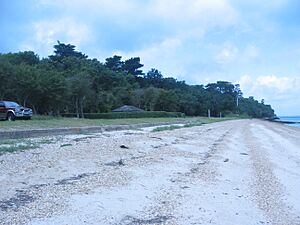
Queen Victoria passed away at Osborne on January 22, 1901. Two generations of her family were with her. Even though she loved Osborne very much and wanted it to stay in the family, her children did not feel the same way. Princess Beatrice and Princess Louise were given houses on the estate. King Edward VII gave Osborne to the nation on his Coronation Day in August 1902. The royal apartments on the upper floors, including the late Queen's bedroom, became a private museum. Only the royal family could visit it at first.
Later Uses
In 1903, the new stable building became a training college for young officers in the Royal Navy. It was called the Royal Naval College, Osborne. Training began around age 13. After two years, students continued their studies at the Royal Naval College, Dartmouth. The college closed in 1921.
Some famous former students of Osborne included Queen Victoria's great-grandsons, who later became King Edward VIII and King George VI. Their younger brother, George, Duke of Kent, also studied there. Another well-known student was Jack Llewelyn Davies. He was one of the five Llewelyn Davies boys who inspired J. M. Barrie's character Peter Pan. A case from 1908, where a student named George Archer-Shee was wrongly accused of stealing, inspired the play The Winslow Boy.
Military Recovery Home
During World War I, some parts of Osborne House were used as a recovery home for officers. Robert Graves and A. A. Milne were two famous patients who stayed there. It was known as the King Edward VII Retirement Home for Officers. It later helped military and civil service members recover, including retired officers, until the year 2000.
Thomas Cubitt, the Master Builder
Thomas Cubitt was one of the most famous architects of the 1800s. People called him "the Emperor of the building trade."
Prince Albert was very impressed with Cubitt's earlier work. So, he asked him to rebuild Osborne House. Cubitt and Prince Albert worked closely together to design and build the house. They created a mix of grand Palladian architecture and Italian Renaissance style. Cubitt not only designed the structure but also added many of his own special touches. He used doors and fireplaces he designed himself. He also created his own patterns for the plaster inside the house.
The design of Osborne House is grand and fit for royalty. However, it is not so grand that it feels unwelcoming. Queen Victoria and Prince Albert wanted to escape the formal atmosphere of Buckingham Palace. They wanted a home where their children could feel free and happy. After Osborne House was finished, they asked Cubitt to build the east wing of Buckingham Palace. Queen Victoria admired Cubitt not just for his work but also for his kind character. She called him "our Cubitt" and said after he died that "a better, kinder-hearted man never breathed."
Preserving History
Since 1986, Osborne House has been looked after by English Heritage. It is open for everyone to visit. The house is a very important historic building, listed as Grade I. Its beautiful park and gardens are also listed as Grade II*.
The old cricket pavilion from the Naval College was turned into a holiday cottage in 2004. Since 2005, the house has sometimes hosted outdoor concerts on the lawn.
Queen Victoria's private beach at Osborne, including her personal bathing machine, was opened to the public for the first time in July 2012. This happened after a lot of work to restore it.
See also
 In Spanish: Castillo de Osborne para niños
In Spanish: Castillo de Osborne para niños


